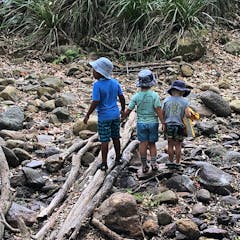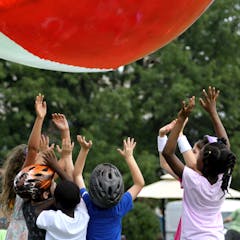
Articles on Outdoor play
Displaying 1 - 20 of 22 articles

How should we understand what toys or ‘loose part’ materials support children’s play, and what’s the relationship of parents’ education and income to this? A study aims to find out.

‘Etuaptmumk’ or Two-Eyed Seeing is the gift of multiple perspectives in the Mi’kmaw language. A key practice of this in an early childhood outdoor program is walking together and sharing stories.

Problems include no fields, no courts for games, no playgrounds, no bike racks and no traffic-calming surrounding the school. Bringing in minimum standards is important.

The pandemic ushered in a renaissance of outdoor living. We need to advance the momentum for outdoor play to support the health and development of children

New research demonstrates the many aspects of nature play that make it a great way for young children to gain STEM knowledge.

Public and community health experts highlight four ways that communities can collaborate to encourage physical activity and fun.

Planning outdoor early learning and child care has implications for training and recruiting educators as well as for planning, developing and funding physical spaces.

Restructuring children’s outdoor play in child care centres into shorter, more frequent bouts helps maximize children’s physical activity.

A psychologist explains why certain goals may be more effective than others in breaking screen habits.

Supporting play begins with parents attending to their own wellness and seeing children as drivers of their own play.

Here are four ways adults can help kids work through their worries about the environment.

In some parts of the US, a silver lining of COVID-19 may be a return to childhood friendships based in neighborhoods.

Global experts in child development say recess will be critical for children’s well-being when schools reopen, so education authorities should see planning recess as a high priority.

Scotland is undertaking a child-care initiative to double the number of fully funded child-care hours available to parents, and outdoor play is part of it.

One father was fined for rollerblading with kids in a parking lot, while other families hit the cottage. Families’ backyard or property status should not determine kids’ right to outdoor play.

Keeping kids active in winter can be a challenge, as cold temperatures and icy conditions often mean more time indoors. Here’s how to maintain a healthy activity level throughout Canadian winters.

On the 30th anniversary of the UN Convention of the Rights of the Child, let’s remember children’s right to play.

Experts in child health and physical activity offer recommendations for training of early childhood educators, and strategies to get kids moving.

Adults must let go of their fears of injury and kidnapping. Children need free outdoor play to build physical immunity, psychological health, executive functioning and social skills.

Summer camps – long the stuff of American lore – can teach kids important life lessons as they have some fun along the way. Two experts on summer camp offer insight into what those lessons are.
